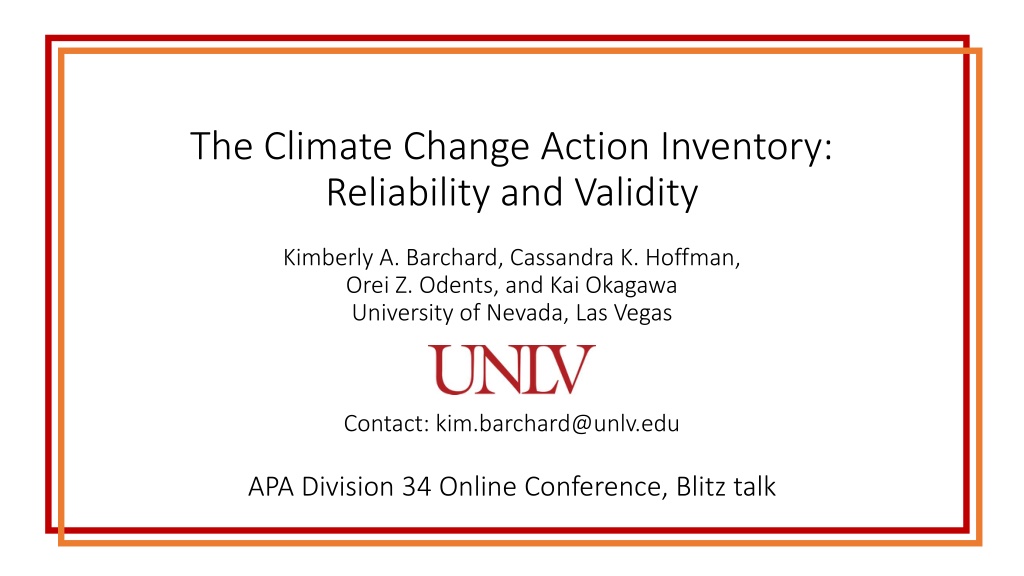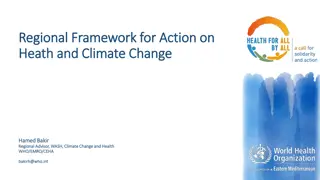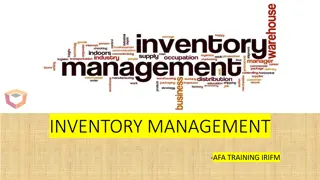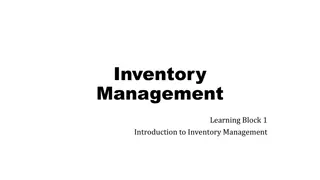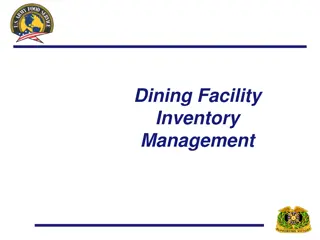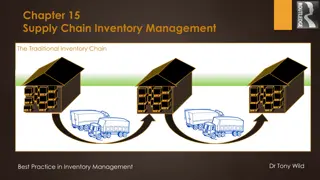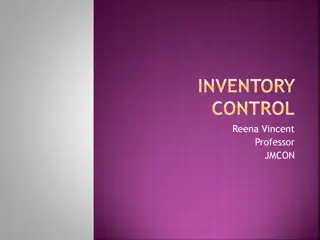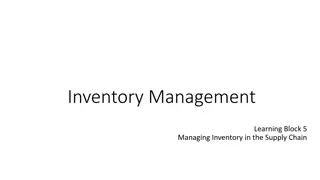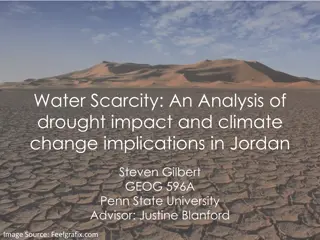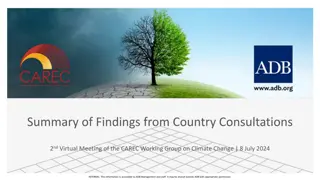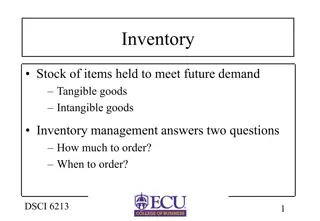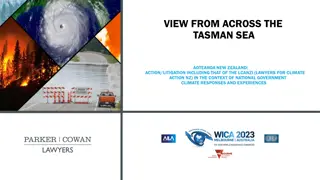Understanding Climate Change Action: Inventory, Reliability, and Factors
The Climate Change Action Inventory comprises 77 items measuring various actions to combat climate change across eight domains. The method involved 500 MTurk workers, with reliability analyses showing strong internal consistency. Findings indicate a positive correlation between climate change anxiety, direct experience with climate change, trust, and the frequency of actions taken.
Download Presentation

Please find below an Image/Link to download the presentation.
The content on the website is provided AS IS for your information and personal use only. It may not be sold, licensed, or shared on other websites without obtaining consent from the author. Download presentation by click this link. If you encounter any issues during the download, it is possible that the publisher has removed the file from their server.
E N D
Presentation Transcript
The Climate Change Action Inventory: Reliability and Validity Kimberly A. Barchard, Cassandra K. Hoffman, Orei Z. Odents, and Kai Okagawa University of Nevada, Las Vegas Contact: kim.barchard@unlv.edu APA Division 34 Online Conference, Blitz talk
Climate Change Action Inventory 77 Items Measuring frequency of actions that can reduce climate change. Several times per week Direct Use public transit Eat vegan / vegetarian meals Air dry laundry Indirect Buy carbon offsets Encourage others to conserve water Give time or money to organizations working to reduce food waste 8 Domains Energy Conservation Water Conservation Transportation Climate-Friendly Food Choices Reducing Food Waste Climate-Friendly Purchasing Choices Recycling Removing Carbon from the Atmosphere 2
Climate Change Action Inventory: Method 500 MTurk workers in the United States Removed 15 climate change deniers 485 Final Sample 203 female, 279 male, 3 non-binary Ages 19 76 (M = 39.6, SD = 11.8) 82.9% Caucasian/White, 8.5% African American/Black, 5.2% Asian 3
Reliability Item analyses Every item correlated positively with their domains Confirmatory factor analysis 8-factor model fit well: CFI = .97, TLI = .97, RMSEA = .058 Internal consistency Every domain had strong internal consistency (range .82 - .97) 4
Climate Change Anxiety r(483) = .64** Most people aren t anxious about climate change (consistent with Clayton & Karazsia, 2020). People who are more anxious are taking more actions. 5
Direct Experience with Climate Change r(483) = .40** Greater experience of climate change is associated with more action (consistent with Clayton & Karazsia, 2020) People who have direct experience of climate change aren t always taking action. 6
Climate Change Trust r(483) = .43** Greater trust is associated with more action (similar to Hine et al. 2013; Li & Monroe, 2017). The people who are trying the hardest vary in their trust. Some people trust others to solve climate change problems and aren t taking action. 7
Climate Change Hope r(483) = .26** Smaller relationship than Li & Monroe (2017; r = .63 with self-efficacy) People who feel little hope are taking few actions. People who are taking many actions are relatively hopeful. 8
Climate Change Action Inventory Available at the end of this PowerPoint Or from kim.barchard@unlv.edu 9
References Barchard, K. A., Hoffman, C. K., Okagawa, K., & Odents, O. (2021). Climate Change Trust Scale. Unpublished psychological test. Available from kim.barchard@unlv.edu Barchard, K. A., Okagawa, K., +Hoffman, C. K., & Odents, O. (2021). Climate Change Action Inventory. Unpublished psychological test. Available from kim.barchard@unlv.edu Clayton, S., & Karazsia, B. T. (2020). Development and validation of a measure of climate change anxiety. Journal of Environmental Psychology, 69, Article 101434. https://doi.org/10.1016/j.jenvp.2020.101434 Hine, D. W., Phillips, W. J., Reser, J. P., Cooksey, R. W., Marks, A. D. G., Nunn, P. D., Watt, S. E., & Ellul, M. C. (2013). Enhancing climate change communication: Strategies for profiling and targeting Australian interpretive communities. National Climate Change Adaptation Research Facility. https://nccarf.edu.au/wp- content/uploads/2019/03/Hine_2013_Enhancing_climate_change_communication.pdf Li, C., & Monroe, M. C. (2018). Development and validation of the Climate Change Hope Scale for high school students. Environment and Behavior, 50(4), 454 479. https://doi.org/10.1177/0013916517708325 11
Appendix A: Climate Change Action Inventory A person's carbon footprint is the amount of greenhouse gases put out as a result of their energy use. This includes energy used directly, like electricity and fuel, as well as the energy it takes to make and transport all the products they use. Individuals can take a variety of actions to reduce their carbon footprint, and they can encourage others to take similar actions. Individually and in groups, people can also problem solve what to do and how to do it. Finally, people can give time or money to organizations working to reduce climate change. Giving includes paid and volunteer work, as well as donations of money, goods, and services. How often do you take each of the following actions? 1 = Less than once a year 2 = Once a year 3 = Several times a year 4 = Once a month 5 = A couple times a month 6 = Once a week 7 = At least 3 times a week 8 = At least 7 times a week 9 = At least 14 times a week 12
Energy Conservation 1. When leaving a room, turn lights off 2. When entering a room, leave lights off 3. Turn off electronics (phones, computers, etc.) when they are not in use 4. Unplug appliances (microwaves, coffee makers, etc.) when they are not in use 5. Air dry laundry 6. Wash laundry in cold water 7. Take cold showers 8. Encourage others to conserve energy 9. Problem solve how to conserve energy 10. Give time or money to organizations working on energy conservation. 13
Water Conservation 1. Take shorter showers 2. Turn off the water while brushing your teeth 3. Turn off the water while washing your hands 4. Turn off the water while soaping in the shower 5. Turn off the water while washing vegetables (or wash them in a bowl) 6. Encourage others to conserve water 7. Problem solve how to conserve water 8. Give money or time to organizations working on conserving water 14
Transportation 1. Attend meetings / classes using computers or phones (instead of in person) 2. Visit friends / family using computers or phones (instead of in person) 3. Work (or attend school) from home 4. Use human-powered transport (walk, bicycle, scooter, etc.) 5. Use public transit (trains, buses, subways, etc.) 6. Carpool 7. Use an electric / fuel efficient car 8. Combine trips to reduce mileage (e.g., shop on the way home) 9. Encourage others to use climate-friendly transportation options 10. Problem solve how to reduce the impact of transportation on climate change 11. Give time or money to organizations working to reduce the impact of transportation on climate change 15
Climate-Friendly Food Choices 1. Choose locally grown food (or food you grew yourself) 2. Choose foods based upon their climate impacts 3. Eat vegan / vegetarian meals 4. Encourage others to choose foods that have less impact on climate change 5. Problem solve how to reduce the impact of food on climate change 6. Give time or money to organizations working to reduce the impact of food on climate change 16
Reducing Food Waste 1. Put new foods in the back of your fridge and pantry (so older foods are at the front) 2. Store leftovers in sealed containers 3. Eat leftovers 4. Compost food scraps 5. Pack your own lunch (rather than letting someone else do it) 6. Encourage others to reduce food waste 7. Problem solve how to reduce food waste 8. Give time or money to organizations working to reduce food waste 17
Climate-Friendly Purchasing Choices 1. Repair things rather than buying replacements 2. Use borrowed, rented, or digital copies of books, music, and movies (rather than buying physical books, CD s, and DVD s) 3. Use borrowed or rented tools and equipment (e.g., laptops, skis, dress clothes, musical instruments, pressure washers, carpet cleaners, party tents) rather than buying them 4. Buy used (from consignment stores, thrift stores, garage sales) rather than new 5. Donate to charity in someone else s name (rather than buying a gift) 6. Choose products that have less packaging 7. Choose products that are made locally 8. Choose products that have less impact on climate change 9. Donate or sell your old possessions (rather than throwing them away) 10. Encourage others to buy less 11. Encourage others to choose climate-friendly products 12. Problem solve how to reduce the impact of purchases on climate change 13. Give time or money to organizations working to reduce purchases (e.g., bike-share programs, book/music libraries, tool-lending libraries, clothing exchanges) 14. Give time or money to organizations working to reduce the impact of purchases on climate change (e.g., environmental regulations, environmental certifications, compostable packaging) 18
Recycling 1. Recycle paper and cardboard 2. Recycle plastic bottles 3. Recycle glass bottles 4. Rinse bottles before recycling them 5. Recycle tin cans and aluminum cans 6. Rinse cans before recycling them 7. Recycle batteries 8. Recycle electronics (phones, computers, TVs, printers, etc) 9. Encourage others to recycle 10. Problem solve how to improve recycling 11. Give time or money to organizations working to improve recycling 19
Removing Carbon from the Atmosphere 1. Plant or take care of trees 2. Pay others to plant or take care of trees (e.g., landscapers, homeowners association) 3. Encourage others to plant or take care of trees 4. Problem solve how to plant or take care of trees 5. Give time or money to organizations that are planting or taking care of trees (e.g., rainforest preservation, forest restoration) 6. Buy carbon offsets (to fund environmental projects that reduce greenhouse gases) 7. Encourage others to buy carbon offsets 8. Problem solve how to improve carbon capture and removal 9. Give time or money to organizations working on carbon capture and removal 20
